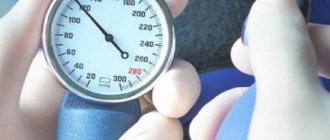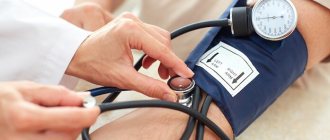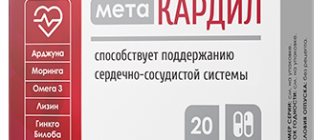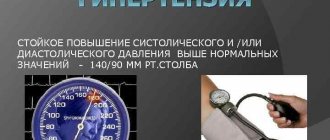14.11.2018
A.A.
(Last update: 01/23/2019)
There are contraindications. Specialist consultation required
Sometimes a situation arises when the number on the tonometer shows a value that immediately makes patients wonder what caused this condition. After all, a pressure of 90 over 80 is not an indicator of normality. It is very important at this stage to properly monitor your well-being and seek medical help in a timely manner.
Any deviations from the norm can cause severe weakness and even provoke serious complications.
Pressure 90 over 80: what does it mean?
Low blood pressure, and even more so a small gap between the upper and lower readings, may indicate the presence of a serious pathology. Using the indicators on the tonometer, you can guess in which organ there are disorders. Thus, an increase in the upper indicator indicates a malfunction in the cardiovascular system, and an increase in the lower indicator indicates improper functioning of the kidneys.
Do not self-medicate. Consult a specialist:
Still, before you start to panic, it is better to measure your blood pressure again after a short period of time. In some cases, numbers can change quite quickly, since various non-standard situations caused such fluctuations.
This could be facilitated by:
You get promotional code OZON - 300 points for your first order. OZONAPIE1I (applied in the cart)
- Physical overexertion;
- Stressful situation;
- Abuse of alcohol or nicotine;
- Lack of sleep.
Such factors in 80% of cases can provoke a pressure of 90 to 80, but sometimes this can be a simple error in measurement, especially if it is carried out at home.
What does blood pressure 90/80 mean?
If you were measuring your blood pressure, you noticed on the tonometer 90 by 80 mmHg. Art. Don’t rush to diagnose yourself and swallow pills. Not all people with low blood pressure need to be treated. Patients experiencing unpleasant symptoms require therapy. If at indicators of 90 to 80 mm Hg. Art. the person feels fine, no treatment is needed - this is the norm for him.
There is a category of people who, with low blood pressure, can lead an absolutely normal life, in particular this applies to women. Hypotonics are much more common among them than among men.
In pregnant women, low blood pressure due to hormonal changes is also normal. Hypotension in pregnant women does not require medical intervention as long as the woman feels normal.
If you feel worse, be sure to consult a doctor. There is a high probability of developing intrauterine bleeding and miscarriage.
In men, hypotension can develop due to emotional exhaustion, environmental influences, bad habits and concomitant diseases.
In adolescents and school-age children, low blood pressure is a sign of a lack of vitamins in the body.
People of retirement age rarely suffer from hypotension; their blood pressure usually rises. If an elderly person feels a constant drop in systolic pressure, only the doctor who conducted the examination can tell what this means.
A short-term decrease in performance is often caused by taking medications.
Are such indicators dangerous?
A lot of people prone to hypotension ask whether this pressure is dangerous?
By itself, a blood pressure reading of 90 over 80 does not pose a threat to life. Only one of the indicators is underestimated, the second is within the normal range. The alarm should be sounded when the lower reading falls below 60 or 50 mmHg. Art. And also read on our website: What does blood pressure 60 over 40 mean, how to raise low levels and what to do at home? This pressure can harm the body if it is caused by blood loss, dehydration or anaphylactic shock. Arterial hypotonicity in the above critical situations provokes serious complications, for example, such as renal failure, loss of consciousness and coma.
To avoid undesirable consequences, as soon as you notice a decrease in blood pressure and begin to notice alarming symptoms, call an ambulance.
How to measure blood pressure correctly
To ensure that the tonometer shows the correct value, it is necessary to carry out the diagnostic procedure correctly. To obtain a more accurate result, it is better to perform the measurement in 2 stages.
Sequencing:
- The procedure must be carried out in a comfortable position. If this happens while sitting, then you should lean on your back, with your hand on the table.
- During this, the cuff should be well secured, and the hand should be at the level of the heart. The bottom edge of the cuff should be above the level of the elbow.
- You should not smoke half an hour before changing the pressure, this can significantly distort the result. If there was emotional overload, then it is also necessary to wait a certain amount of time.
- To obtain accurate data, at least two measurements should be taken. The average interval will be 5 minutes. It is very important that the cuff matches the size when measuring, otherwise this can also greatly distort the result.
Causes of pathology
If the readings on the tonometer record the same pressure of 90 to 80 over different periods of time, then the cause of this may be the presence of a serious illness. In this case, the trigger mechanism could be several factors simultaneously.
Possible reasons:
- Bradycardia;
- Vascular atherosclerosis;
- Narrowing of the aortic mouth;
- Myocarditis;
- Hepatitis;
- Pathology of the heart valve;
- Cardiosclerosis;
- Diabetes;
- Blood loss.
In fact, such serious diseases do not develop that often. At this moment it is very important to monitor your condition. If chronic processes have already made themselves felt, then the prerequisites for this should already have existed.
What factors can lead to a decrease in upper pressure:
- Severe fatigue;
- Emotional stress;
- Pregnancy;
- Dehydration;
- Avitaminosis;
- Hangover syndrome;
- Changing of the climate;
- Weather.
It should also be taken into account that only people who already have any problems with blood vessels or a family history can be subject to such fluctuations. The additional load has simply led to a failure in the circulatory system.
Pulse
Pulse at 90 to 80 mmHg. Art. should be 60-80 strokes for older people, 70-90 for middle-aged people and 80-110 for children and trained athletes.
A decrease in blood pressure does not mean that the heart should slow down. If the number of heartbeats decreases, be sure to call an ambulance.
Lack of pulse with a pressure of 90 to 80 is a sign of internal bleeding or a pre-stroke condition.
And also read on our website: What does pressure 150 to 110 mean, what are the reasons and what to do with such indicators?
How to help yourself with blood pressure
Since with such blood pressure levels we most often have to talk about a deterioration in brain activity, it is important at this stage to provide full assistance to the blood vessels. If blood pressure remains low for a long time, the risk of ischemic stroke increases.
In some cases, it is possible that the pressure is 90 to 80, and the pulse is 80. Changing the heart rate can be an additional way to diagnose the patient’s condition. A decrease in heart rate may indicate diseases of the thyroid gland or pathology of the adrenal glands.
If the heart rate continues to increase and reaches 120, then this value already indicates other pathological conditions. This could be vegetative-vascular dystonia, vascular atherosclerosis, or even viral damage to the brain. As such, only a qualified specialist can find out the reasons and prescribe the correct treatment.
How to help yourself in this situation:
- Take a horizontal position and try to calm down as much as possible. Since the pressure has dropped sharply, there is a risk that the result may even be fainting.
- The legs need to be elevated in such a way as to ensure adequate blood flow to the head. Thanks to this position, the upper pressure can increase slightly.
- The body needs to be relaxed as much as possible and freed from tight clothing. This is necessary so that breathing becomes free and oxygen is fully supplied to the brain.
- If you feel severe weakness and chills, you need to warm up. In this case, you should cover yourself with a blanket and drink warm, strong tea.
In addition, you need to seek emergency medical help, because a slight difference in blood pressure can indicate another pathology.
In some cases, if medical assistance is not provided in time, the consequences can be very negative, including the death of brain tissue and damage to the organs of vision and hearing.
Possible therapy for hypotensive conditions
Low blood pressure itself is a consequence of another process. To cope with it, it is first necessary to neutralize the factor that led to its appearance.
Suitable drug therapy:
- Adaptogens;
- Multivitamin preparations;
- Analeptics;
- Alpha adrenergic agonists.
Medicines of the first group will help cope with increased weakness and easily relieve apathy and weakness. Since they are of plant origin, they have virtually no contraindications for use.
Adaptogens include:
- Eleutherococcus;
- Schisandra chinensis;
- Ginseng root;
- Radiola pink.
They are usually taken in the form of infusions, which are sold ready-made in pharmacies. Multivitamin preparations will speed up metabolic processes and increase the body's resistance. Analeptics act at the level of the central nervous system. They help to significantly improve blood circulation and nutrition of brain vessels.
The second important point in treating low blood pressure is changing your usual lifestyle. Hypotension is often experienced by people who lead a sedentary lifestyle.
It is important to remember that if you give a sudden load at such a familiar rhythm, the vessels will experience severe stress, and then it will become even more difficult to control your condition.
What to do?
When faced with hypotension for the first time, people do not know what to do and simply ignore their condition. You can't do this. Don't be lazy to see a doctor. If provoking diseases are discovered during the diagnostic process, drug therapy is aimed at eliminating them.
Often, hypotension is a sign of vegetative-vascular dystonia. In this case, drug treatment fades into the background. To stabilize blood pressure, doctors recommend that patients adhere to the following rules:
- Drink 2-2.5 liters of liquid every day. Water helps replenish blood volume and increase pressure on the vascular walls.
- Start your morning with strong tea or coffee - these drinks will tone your blood vessels.
- Try to always carry a piece of dark chocolate with you. If you feel dizzy or weak, chocolate will increase blood flow and eliminate the unpleasant clinical picture;
- After a hard day, take a contrast shower.
- If unpleasant signs of hypotension appear, massage the collar area yourself or ask for it.
Are you feeling an attack of arterial hypotension? Lie down and elevate your legs. This will speed up the blood supply to the brain and heart muscle.
Drink a cup of strong coffee, preferably brewed. Beetroot or pomegranate juice also improves blood circulation and restores the patient’s well-being.
Is it necessary to take medications?
If the above recommendations do not bring results, you will have to take advantage of the achievements of pharmacology. The therapist will tell you what exactly to take, but, as a rule, he prescribes:
caffeine-containing drugs: Citramon, Pentalgin, Piracetam, Ephedrine, Algon;- adaptogens: tincture of ginseng, lemongrass, eleutherococcus;
Blood pressure is increased with the help of drugs with a high content of B vitamins. Decoctions of yarrow, nettle, tansy and calendula have a good effect.
L-carnitine, Potassium Orotate, Panangin, Hypotensin Plus and Glutamic acid can be prescribed as adjuvant therapy.
Pressure 190 over 80: what to do
The opposite situation may also arise when two indicators are rapidly growing upward. In this case, we are already faced with a hypertensive crisis, and the reasons for its development will be completely different. At this stage, timely medical assistance is also important.
A patient in a critical situation may experience increased headache and dizziness, which are accompanied by tachycardia. Before the ambulance arrives, it is necessary to ensure a full flow of fresh air and at the same time provide the patient with complete rest. A cold compress can also provide some relief if you place it on your forehead.
As for medications, the patient can be given an antispasmodic and a diuretic. This will help relieve the load on the blood vessels; the rest of the prescription of drugs is carried out only by a specialist. A timely therapeutic course will further minimize the development of a hypertensive crisis and its consequences.
How does it manifest?
The diagnosis of hypotension is made when, along with a decrease in blood pressure, pathological symptoms occur in a person.
This situation is caused by a lack of blood supply to the internal organs. If not enough oxygen reaches the brain, patients feel dizzy and sometimes even lose consciousness.
Dizziness can occur with a sudden change in body position - this is the so-called orthostatic hypotension.
Hypotension is manifested by drowsiness, general weakness, headache, confusion, and decreased performance. The disease may be accompanied by autonomic disorders, for example, sweaty palms, a feeling of lack of air, and a decrease in body temperature.
Causes of increased pressure
Hypertension is widespread these days. The prerequisites for its appearance can be very different. Regardless of the gap between the upper and lower pressure, the factors that provoked it are the same and always similar.
Frequent causes of the disease:
- Bad habits;
- Sedentary lifestyle;
- Obesity;
- Metabolic disease;
- Diabetes;
- Vascular atherosclerosis;
- Kidney diseases;
- Adrenal tumor.
In addition, we must not forget that stressful situations are often the trigger for many diseases. This is due to the fact that our body is one whole system and everything in it is interconnected.
At the moment of stress, the release of adrenaline sharply increases, which is precisely responsible for the increase in blood pressure.
If the psychological load is constant, then it turns out that the body is under stress continuously. In addition to increased blood pressure, such people often also experience tachycardia. As a result, the severity of the critical condition only increases.











